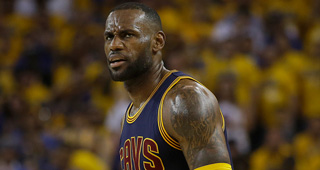LeBron James’ jump shot is the most important variable in the NBA Finals. Whenever he narrows his eyes, bends his legs, springs up and slings the ball with a crescent-moon arc towards the hoop, everyone who wants the Golden State Warriors to win this series momentarily exhale—aka the exact opposite reaction whenever Steph Curry or Klay Thompson let it fly.
In some ways, the possession’s climax is already over the second a ball leaves LeBron’s fingertips. If only for one moment his opponent (in this case the Warriors) feels relief because that shot is, statistically speaking, a total gift. James entered this postseason shooting 30.9 percent behind the three-point line, his least-accurate mark since he was a rookie.
He also—relative to the previous 12 seasons—abandoned the mid-range game; his average field goal attempt in 2010 came 13.4 feet from the basket (a career long), while this past year it was 9.6 feet (a career short).
Getting to the hoop is smart when you’re 6’8”, made of titanium, can accelerate like a Ferrari and have the hand-eye coordination, deft touch and unbridled strength to finish through, above and around just about any defender in the league.
In that way, LeBron’s relationship with his jumper is more confusing than ever before. He’s in a predicament every time he rises up to shoot. The jump shot is always in his bag, but has never been critical, like a 3-wood or sand wedge; given how dominant he is just about everywhere else, leaning on it too often bails out the opposition.
James is colossus in the post, a black hole who sucks in help defenders before a quick pass to the open man leads to a wide open three or a thunderous drop step into the restricted area leads to a dunk.
Speaking of, LeBron dunked 111 balls this season, which is two more than when he was 23, three more than when he was 22 and 13 more than his first year with the Miami Heat, despite playing 354 fewer minutes. He’s still unstoppable on drives into the paint, too, scoring over three quarters of the time.
The only option defending his ball screens is to dive under, cut off potential streaks into the paint and pray he settles from 18 feet. But even then, the irony of forcing those shots is there’s absolutely nothing scarier than watching them fall through the net.
Bomb shelters are better protection than even the timeliest defensive rotations when James has legitimate confidence in his jumper. As we saw leading up to the Finals, very few defenses (if any) can slow the 31-year-old down when he isn’t a direct threat from the perimeter.
In recent years, LeBron’s outside shot can only be considered weak in the relative sense. As in, since every other part of his game is virtually flawless, drawing a pull-up jumper is the one chance for survival. But James voluntarily disconnected himself from the outside more so than ever before this season, instead opting for more shots within three feet of the basket than any other point in his career.
James’ inward migration is even more dramatic in these playoffs. After launching a career-low 22.3 percent of his shots from the mid-range during the regular season, LeBron is now down to 18 percent over his last 19 games.
In the first round, he shot 4-of-19 from behind the three-point line and 6-of-17 from the mid-range. In the second round, he was 8-of-19 from deep and 5-of-11 from the mid-range. In the conference finals, which lasted two fewer games than the first two rounds combined, LeBron shot 7-for-21 from beyond the arc and 7-of-16 from the mid-range.
Cobble all this information together and what this means is LeBron either didn’t want to use his jumper or he didn’t have to.
Not to suggest he’s deserted the paint in these Finals, but over the past three games James has turned to the one part of his game that truly makes him invincible—in part because the Warriors are really good at taking away Plan A. LeBron’s accuracy isn’t quite there, but his increased willingness to fire away is a promising sign. A steady 25.5 percent of his field goal attempts were pull-up jumpers heading into the Finals, but over the last three games it’s up to 40.3 percent (it was 30.2 percent during the regular season).
His eight three-point attempts in Game 5 were only topped twice all year, and his four makes were only topped once. None of these numbers can help us predict James’ shot selection over the next couple games, but the Cavaliers are just about impossible to stop when he strikes the proper inside-outside balance.



